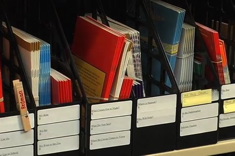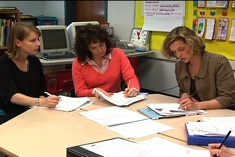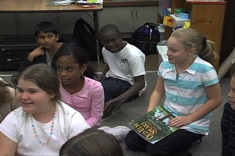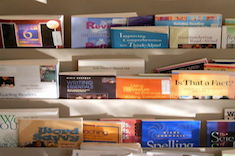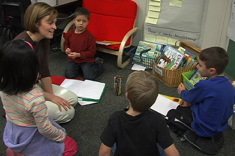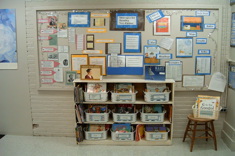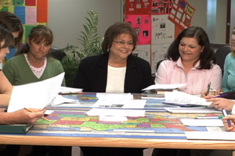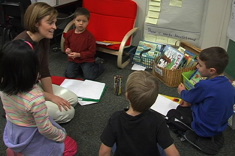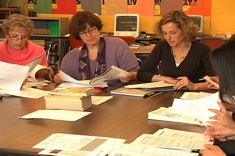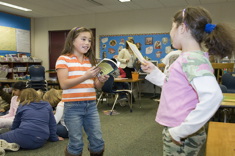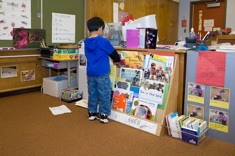Library
Choice Literacy Articles & Videos
The Choice Literacy library contains over 3,000 articles and 900 videos from 150+ contributors. Classic Classroom and Literacy Leadership subscribers have access to the entire library. Content is updated continuously, with five to six new features published each week.
Latest Content
Books for Phonics Instruction – Accomplishing More Than Just Sounding Out Words
Shari Frost finds herself appalled at some of the "books" children are reading in the name of phonics instruction, so she sets out to create a booklist of high quality children's literature that does more than just help children sound out words.
From Congeniality to Collegiality: Protocols for Meetings and Observations
Clare Landrigan and Tammy Mulligan suggest a few tested and successful protocols for meetings and study groups that foster more thoughtful conversations.
What My Son’s Reading Difficulties Taught Me About Teaching Struggling Readers
No matter how many education methods courses and professional development workshops you take, if you’re a parent, your children will always teach you the most about how students learn. Tammy Mulligan shares three practical strategies for reaching struggling readers that she learned from experiences with her son.
From “Data Drowning” to “Data Wise”: What Are We Doing Now?
Clare Landrigan and Tammy Mulligan provide an activity for staff meetings designed to help schools sort through the purpose and value of current assessments.
More Teaching Metaphors
Ruth Shagoury considers her struggles with "beginner's mind" in yoga and mountain biking, and what they can both teach her about students who are struggling with any new learning.
Getting the Most Out of Picture Books
If you are a fan of Mo Willems’ picture books (and who isn’t?), you’ll enjoy Katie DiCesare’s ideas for integrating his popular stories throughout the literacy curriculum. From read-alouds to mentor texts, these books are wonderful tools for engaging students.
Bucking Broncs and Spitting Bulls
Andie Cunningham finds a rodeo reminds her of the opening days of school, and how timed assessments can cloud our vision of students early in the year.
Using Poetry to Promote Reading Fluency
Aimee Buckner shares how to use a mentor text to build fluency through poetry.
Building a Professional Library from Scratch
There are so many new professional books available for literacy leaders to purchase…and so little funding to buy them. Shari Frost gives the details of how one coach surveyed colleagues, assessed needs, and rooted out bargains before spending the precious $500 allocated for stocking the professional book library.
Step by Step: Integrating Nonfiction into Primary Classroom Instruction
Nonfiction texts require different reading skills than fiction, and you can’t introduce nonfiction genres to children too early. Katie DiCesare shares how she moves between whole-class, small-group, and individual instruction to help all her first graders master the text features in nonfiction.
Rethinking a Study of Nonfiction Writing
Franki Sibberson reflects on her nonfiction writing unit, and realizes she emphasizes research skills at the expense of the craft of nonfiction writing.
Novels in Verse (BOOKLIST)
Franki Sibberson provides a booklist of "novels in verse" – a genre intermediate readers enjoy, especially those who struggle with longer texts.
Questions and Answers about Home Reading Logs
Readers enjoyed Mandy Robek’s explanation of her move to home reading logs in a calendar format, and some wrote in with additional questions about the program. Mandy provides a follow-up article in a question and answer format, addressing issues raised by readers.
Hallmarks of Reading Workshop
Karen Szymusiak works with her staff to develop "Hallmarks of Reading Workshop," which is a succinct and concrete list of expectations for time, components, and organization of workshops. The list would be an excellent jumping off point for discussion in a staff meeting of bottom-line standards and allocation of time for literacy activities.
Eight Tips for Building Relationships: A Tale of Two Literacy Coaches
Shari Frost presents a tale of two literacy coaches – one who has had success building close relationships with colleagues, and one who has struggled. In analyzing their experiences, she presents eight practical strategies for building relationships over time.
Better Discussions in Study Groups
Cindy Hatt has suggestions for getting the most out of book studies with colleagues, with activities and prompts that can help you move from ideas to practice in classrooms.
Teaching Economics with Children’s Literature
Mandy Robek shares some of her favorite children’s books for teaching economics.
Time Quote Collection
Quotes about time that have. . .well, stood the test of time.
Reflecting on Student Work in Staff Meetings (TEMPLATE)
Jennifer Allen describes a protocol for analyzing student work in teacher study groups and staff meetings, and includes a template for discussing classroom artifacts.
Overcoming Tears and Fears: Developing Criteria for Flexible Groups
Katie DiCesare comforts a student in tears at the end of the day, and realizes part of the problem may be that she moved the child into a guided writing group too quickly.
Wide Open Spaces: Learning from “Not-Just-Right” Books
When is it okay for a child to read a "not-just-right" book, especially one with themes that might be a bit sophisticated or of questionable taste? Andrea Smith confronts this issue as a parent, and thinks through what it might mean for her teaching.
Moving from Data to Practice
Clare Landrigan and Tammy Mulligan give advice for how to create databases and graphic analyses of assessment information that teachers can readily access and use.
The Draw-a-Reader Test: Informal Assessment Supporting Teacher Inquiry
The Draw-a-Reader test from Suzy Kaback is a fun way to get to know the readers of any age that also provides insight into their background knowledge and personal reading histories.
Tips for Saving Time from Literacy Leaders
Time-saving tips from contributors including Aimee Buckner, Debbie Miller, Ruth Shagoury, Shari Frost, Karen Szymusiak and "The Sisters" (Gail Boushey and Joan Moser).
Easing into Assessments During the First Six Weeks of School
Franki Sibberson and Karen Szymusiak have suggestions for integrating observations and assessments of students naturally into reader's workshops during the first six weeks of school.
“I Used to . . . Now I”
Looking for a thoughtful and feel-good icebreaker for a staff meeting or study group? Ruth Shagoury uses the “I Used to…Now I” prompt to get colleagues thinking and talking about changes in their literacy instruction over the years, as well as where they might go next in their teaching.
Books that Invite Student Participation
Franki Sibberson has suggestions for read-alouds that encourage kids to participate.
Characters We Love (BOOKLIST)
Nothing hooks kids on books more than a favorite character. Franki Sibberson presents some series books with intriguing characters that will delight your students.
Multicultural Books for Beginning Readers
“Why isn’t there an African American Henry and Mudge?” asks a teacher. This question leads Shari Frost on a quest to find the best early readers for multicultural students. In this booklist, she highlights her top picks.
Music for Literacy Leaders
Reflective? Rollicking? If you’re trying to set a tone for anything from an assessment team meeting to a one-minute transition in a second-grade classroom, our Music for Literacy Leaders playlist has just the right song for you.
Browse Content By
Type
Category
- Assessment Tools
- Big Fresh Archives
- Booklists
- Choice Numeracy
- Classroom Design
- Common Core
- Community Building
- Conferring
- Content Literacy
- Digital Literacy
- English Language Learners
- Equity
- Family Relations
- Free Samples
- Guiding Groups
- Leadership
- Literacy Coaches
- Mentor Texts
- Minilessons
- New Teacher Mentors
- Podcasts
- Poetry
- Quote Collections
- Reading Strategies
- Self Care
- Struggling and Striving Learners
- Talking and Listening
- Teacher Study Groups
- Teaching Reading
- Teaching Writing
- Word Study and Vocabulary
Author
- Melissa Quimby
- Nawal Qarooni
- Gwen Blumberg
- Julie Cox
- The Lead Learners
- Ruth Metcalfe
- Mallory Messenger
- Becca Burk
- Jodie Bailey
- Vivian Chen
- Mary Brower
- Stephanie Affinito
- Ruth Ayres
- Leigh Anne Eck
- Heather Fisher
- Shari Frost
- Julie Johnson
- Suzy Kaback
- Clare Landrigan
- Gigi McAllister
- Shirl McPhillips
- Melanie Meehan
- Cathy Mere
- Debbie Miller
- Tara Barnett and Kate Mills
- Tammy Mulligan
- Dana Murphy
- Bitsy Parks
- David Pittman
- Brenda Power
- Heather Rader
- Matt Renwick
- Mandy Robek
- Christy Rush-Levine
- Gretchen Schroeder
- Jen Schwanke
- Brian Sepe
- Katherine Sokolowski
- Stella Villalba
- Jennifer Vincent
Grade Level
Choice Literacy Membership
Articles
Get full access to all Choice Literacy article content
Videos
Get full access to all Choice Literacy video content
Courses
Access Choice Literacy course curriculum and training

